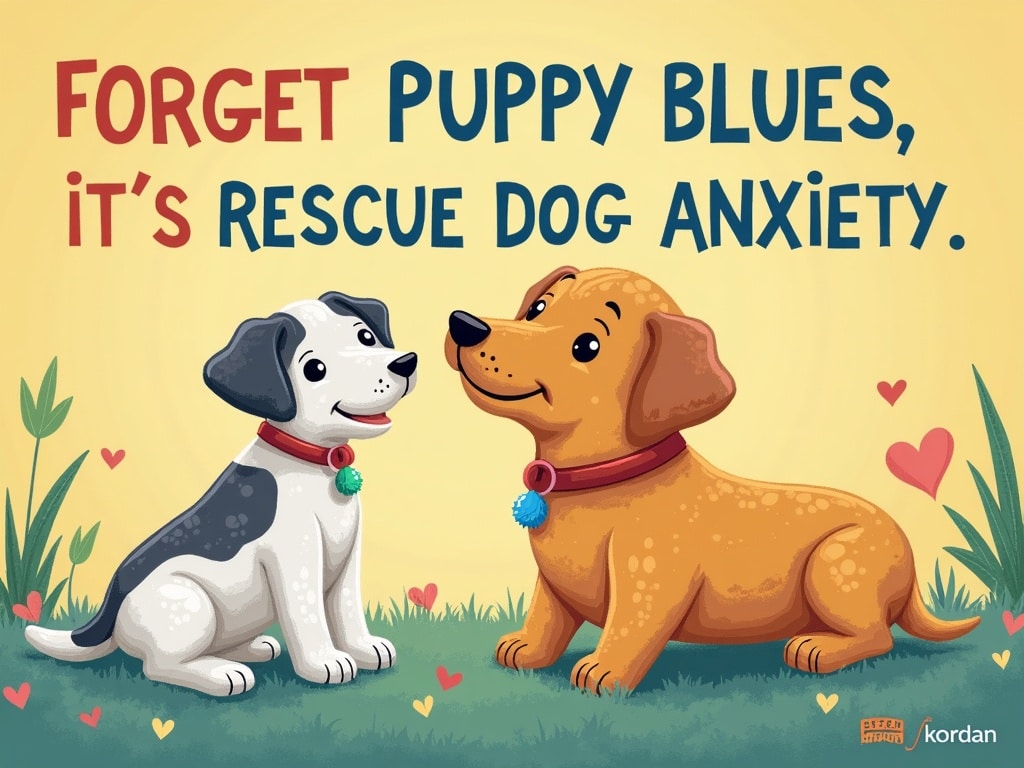Forget Puppy Blues, It’s Rescue Dog Anxiety: How to Cope and Find Joy
Bringing a rescue dog into your life is a beautiful act of compassion. You’re offering a deserving animal a second chance at a loving home. However, the transition isn’t always smooth. Unlike puppies who’ve known little else, rescue dogs often arrive with a baggage of anxieties stemming from past experiences. Forget the typical puppy blues; navigating rescue dog anxiety requires understanding, patience, and proactive management. This comprehensive guide will equip you with the tools and knowledge to help your rescue dog overcome their fears and flourish in their new life.
Understanding Rescue Dog Anxiety
Anxiety in rescue dogs is rarely a simple case of nerves. It’s usually a complex interplay of factors related to their history. Common causes include:
- Past Trauma: Experiences like abuse, neglect, or abandonment can leave lasting emotional scars.
- Shelter Stress: The shelter environment is often noisy, crowded, and unpredictable, contributing to heightened anxiety.
- Sudden Change: A change of environment, new people, and unfamiliar routines can be overwhelming.
- Lack of Socialization: If a dog wasn’t properly socialized as a puppy, they might be fearful of new people, places, and sounds.
- Medical issues: Sometimes anxiety can be caused, or worsened by underlying medical concerns.
Understanding the potential origins of your dog’s anxiety is the first step toward helping them heal.
Identifying Anxiety Symptoms in Your Rescue Dog
Recognizing the signs of anxiety is crucial for timely intervention. Anxiety manifests differently in each dog, but common symptoms include:
- Body Language: Tucked tail, lowered head, flattened ears, trembling, pacing, panting, excessive licking, yawning, or drooling when not hot or thirsty.
- Behavioral Changes: Hiding, destructive behavior (chewing, digging), excessive barking, aggression, or changes in appetite and sleep patterns.
- Vocalization: Whining, whimpering, or howling when left alone or in specific situations.
- Avoidance: Trying to escape situations, shying away from touch, or refusing to move.
- Compulsive Behaviors: Repetitive actions like tail chasing or paw licking.
Don’t dismiss what might seem like quirks. These are probably your dog’s ways of communicating they are feeling stressed or unsafe.
Creating a Safe and Secure Haven
Your home needs to be your rescue dog’s sanctuary. Designate a safe space where they can retreat when feeling overwhelmed.
- Choose a quiet area: A spare room, corner of a room, or even a large crate can work.
- Make it comfortable: Provide a soft bed, familiar toys, and a blanket that smells like you.
- Limit access: Ensure family members and other pets respect your dog’s safe space and don’t disturb them when they’re there.
Think of it as their personal den, a place of refuge where they feel secure and in control. Pheromone diffusers can also add to creating a calming environment.
The Importance of Routine and Predictability
Anxiety thrives on uncertainty. A consistent daily routine can dramatically reduce anxiety levels in rescue dogs.
- Establish set feeding times: Feed your dog at the same times each day.
- Regular walks: Maintain a consistent walking schedule, even if it’s just a short walk around the block.
- Predictable playtime: Incorporate playtime into the daily routine.
- Consistent bedtime: Establish a regular bedtime routine to promote restful sleep.
Knowing what to expect provides a sense of safety and control, allowing your dog to relax and feel more secure.
Positive Reinforcement Training Methods
Training should never involve punishment or force. Anxious dogs respond best to positive reinforcement techniques. This means rewarding desired behaviors with treats, praise, or toys.
- Clicker training: A clicker can be used to mark the exact moment your dog performs the desired behavior, followed immediately by a reward.
- Reward-based training: Focus on rewarding good behavior. Ignore or redirect unwanted behaviors.
- Keep sessions short and fun: End sessions on a positive note, before your dog gets tired or frustrated.
The goal is to build confidence and create a positive association with training.
Counter-Conditioning and Desensitization
These techniques help change your dog’s emotional response to specific triggers. For example, if your dog is afraid of vacuum cleaners, you can use counter-conditioning and desensitization to change their perception.
- Desensitization: Gradually expose your dog to the trigger at a low intensity (e.g., the vacuum cleaner in another room).
- Counter-conditioning: Pair the trigger with something positive, like a tasty treat or favorite toy, when the trigger is present.
The key is to proceed slowly and never force your dog to confront their fears. If they show signs of anxiety, back off and decrease the intensity of the stimulus.
The Role of Exercise and Mental Stimulation
A tired dog is often a less anxious dog. Regular exercise helps burn off excess energy and release endorphins, which have mood-boosting effects.
- Daily walks: Adjust the length and intensity of walks to suit your dog’s physical abilities and energy levels.
- Playtime: Fetch, tug-of-war, and puzzle toys provide both physical and mental stimulation.
- Training sessions: Training sessions are a great way to tire your dog out mentally.
Variety is key. Mix up your dog’s activities to keep them engaged and prevent boredom.
Diet and Supplements for Anxiety

Nutrition plays a significant role in overall well-being, including mental health. Some studies show certain deficiencies can make anxiety worse. Consider:
- High-quality dog food: Choose a food with real meat, limited fillers, and no artificial additives.
- Omega-3 fatty acids: Found in fish oil, these can help reduce anxiety and improve cognitive function.
- Probiotics: These support gut health, which can impact mood and behavior.
Discuss any dietary changes or supplements with your veterinarian, especially if your dog takes any medications.
When to Seek Professional Help
If your dog’s anxiety is severe or doesn’t improve with home management strategies, it’s time to seek professional help. Signs that professional intervention is needed include:
- Aggression: If your dog is showing aggression toward people or other animals.
- Self-harm: If your dog is engaging in self-destructive behaviors, like excessive licking or chewing.
- Panic attacks: If your dog freezes and shuts down frequently.
- Lack of improvement: If you’ve been implementing management strategies for several weeks with no noticeable improvement.
Your vet can rule out any underlying medical conditions and, if necessary, refer you to a board-certified veterinary behaviorist or a certified professional dog trainer with experience in anxiety management.
Building Trust and Bonding with Your Rescue Dog
Trust is the foundation of a strong relationship with your rescue dog. It takes time and consistency to build trust, especially with dogs who have a history of trauma.
- Be patient: Don’t rush the process. Allow your dog to adjust at their own pace.
- Use positive reinforcement: Reward good behavior and avoid punishment.
- Respect their boundaries: Pay attention to your dog’s body language and give them space when they need it.
- Spend quality time together: Even just sitting quietly with your dog can help them feel safe and secure.
As you bond with your dog, they will start to feel more secure and trusting, naturally reducing their anxiety.
Managing Separation Anxiety
Separation anxiety is a common issue in rescue dogs. They may panic when left alone, even for short periods.
- Start slowly: Begin by leaving your dog alone for just a few minutes, gradually increasing the duration.
- Create a departure routine: Keep your departures and arrivals low-key and matter-of-fact.
- Provide enrichment: Leave your dog with puzzle toys or a stuffed Kong to keep them occupied while you’re gone.
- Consider medication: If separation anxiety is severe, your veterinarian may recommend medication.
Never punish your dog for exhibiting separation anxiety. This will only make their anxiety worse.
Dealing with Specific Phobias
Many rescue dogs have specific phobias, such as a fear of thunder, fireworks, or loud noises. You can use counter-conditioning and desensitization techniques to help your dog cope with these fears.
- Create a safe space: During a thunderstorm or fireworks display, provide your dog with a safe, quiet place to retreat, such as a crate or closet.
- Play calming music: Classical music or white noise can help mask the sounds of the phobia trigger.
- Use a Thundershirt: These snug-fitting vests apply gentle pressure, which can have a calming effect on some dogs.
Talk to your vet about prescription medications to help with these phobias if needed.
Introducing Your Rescue Dog to New People and Animals
Introducing your dog to new people and animals can be stressful for an anxious dog. Proceed slowly and cautiously.
- Controlled introductions: Introduce new people and animals in a controlled environment, such as a leash walk.
- Positive reinforcement: Reward your dog for calm and relaxed behavior around new people and animals.
- Supervise interactions: Always supervise interactions between your dog and new people or animals, especially in the beginning.
- Provide an escape route: Make sure your dog has the option to retreat to a safe space if they become overwhelmed.
Never force your dog to interact with new people or animals if they are showing signs of anxiety.
Long-Term Management and Support
Managing anxiety in rescue dogs is an ongoing process. It requires patience, consistency, and a commitment to providing your dog with the support they need.
- Maintain a consistent routine: Continue to provide a structured and predictable environment.
- Provide regular exercise and mental stimulation: Keep your dog’s mind and body active.
- Continue positive reinforcement training: Reinforce desired behaviors and avoid punishment.
- Monitor for changes in behavior: Be aware of any changes in your dog’s behavior that may indicate increased anxiety.
Regular veterinary check-ups are also important to ensure your dog’s physical health is not contributing to their anxiety.
Celebrating Small Victories
Remember to celebrate every small victory along the way. Whether it’s a relaxed tail wag, a successful training session, or simply a peaceful nap, acknowledge your dog’s progress and your hard work. These small wins create a positive feedback loop and help sustain your motivation.
Bringing a rescue dog into your life is a rewarding journey. By understanding, patience, and dedication to managing their anxiety, you can help your rescue dog overcome their fears and live a happy, fulfilling life. The unconditional love they offer in return is well worth the effort.

